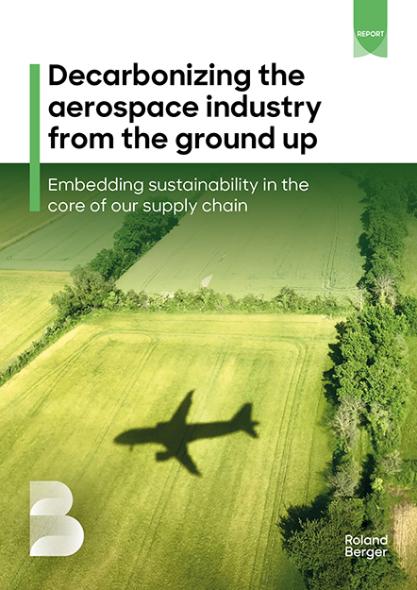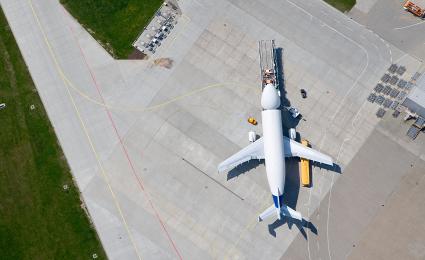How can aerospace companies strengthen their supply chain in an era of extreme volatility and missed delivery deadlines? In 2024, Roland Berger put that and other questions directly to around 150 companies in Germany, France and the UK in an exclusive survey designed to assess the health and future readiness of their supply chains.


Decarbonizing the aerospace industry from the ground up
Embedding sustainability in the core of our supply chain
The aerospace industry is not immune from the mounting pressure to act on sustainability. Despite its technological advancements, the industry currently lags behind other sectors not only in environmental matters but also in social and governance criteria. The demand for meaningful action is not going away; in fact, it is likely to increase as stakeholders prioritize sustainability more than ever.

The bulk of the aerospace industry's emissions fall under Scope 3, particularly in downstream Category 11 (Use of Sold Products) and upstream Category 1 (Purchased Goods and Services). While the largest portion of emissions lies downstream and the main levers to address them have been clearly identified, timely implementation remains a significant challenge. Recognizing these long-term challenges, the aviation sector is targeting net zero by 2050.
"Emissions accumulate throughout the value chain, and no single organization can tackle this alone. Fostering a collaborative ecosystem will be essential."
However, the supply chain offers an immediate opportunity to decarbonize the industry from the ground up. After all, addressing emissions at their source is crucial for comprehensively tackling the industry's carbon footprint. The aerospace supply chain has already demonstrated its innovative potential with carbon fiber reinforced plastic airframes, significantly reducing fuel consumption. Future breakthroughs in aircraft design that will drive the industry's decarbonization are likely to come from the supply chain, highlighting its crucial role in the industry's decarbonization efforts.
But where’s the carbon?
The first step to decarbonizing the supply chain is to understand where the carbon sits. The carbon footprint of aerospace products begins long before components reach final assembly, with a substantial portion of emissions embedded in raw materials and early manufacturing processes. For instance, the production of aluminum, titanium, and composite materials – all crucial to aerospace manufacturing – are energy-intensive processes that contribute significantly to the industry's overall carbon footprint. This highlights the critical importance of addressing emissions at the earliest stages of production.
The complexity of aerospace supply chains, often spanning multiple tiers and geographical locations, further complicates efforts to track and reduce emissions. This intricate web of suppliers and processes makes collaboration essential if the aerospace industry is to decarbonize its supply chain.
Why engaging the suppliers matter?
There is a wide spectrum of ESG maturity among the aerospace supply chain. This diversity requires aerospace companies to tailor their strategy when engaging with their suppliers on ESG. A blanket approach for all suppliers won't cut it.
To effectively and efficiently manage supplier engagement, aerospace companies should classify their suppliers based on two key factors: the potential impact of each supplier on the company's Scope 3 emissions, and the supplier's current level of maturity in its decarbonization journey. Segmenting suppliers in this way enables organizations to cluster their suppliers into three distinct groups, each requiring a specific approach for engagement and ambition for decarbonization.
By implementing a tailored strategy, aerospace companies can engage their diverse suppliers more effectively, addressing challenges and capitalizing on opportunities. This approach not only optimizes resource allocation but also maximizes decarbonization efforts and fosters a collaborative ecosystem that drives sustainable innovation throughout the aerospace supply chain.
What’s next?
Achieving sustainability in the aerospace supply chain is a long and complex journey, but embedding sustainability at its core is crucial for securing the industry's future license to operate. To navigate the way forward, organizations should consider several fundamental questions outlined in our study below.
Register now to access the full study, to get more insights on embedding sustainability in the aerospace supply chain.

_image_caption_none.jpg?v=1080498)






_person_320.png?v=770441)
